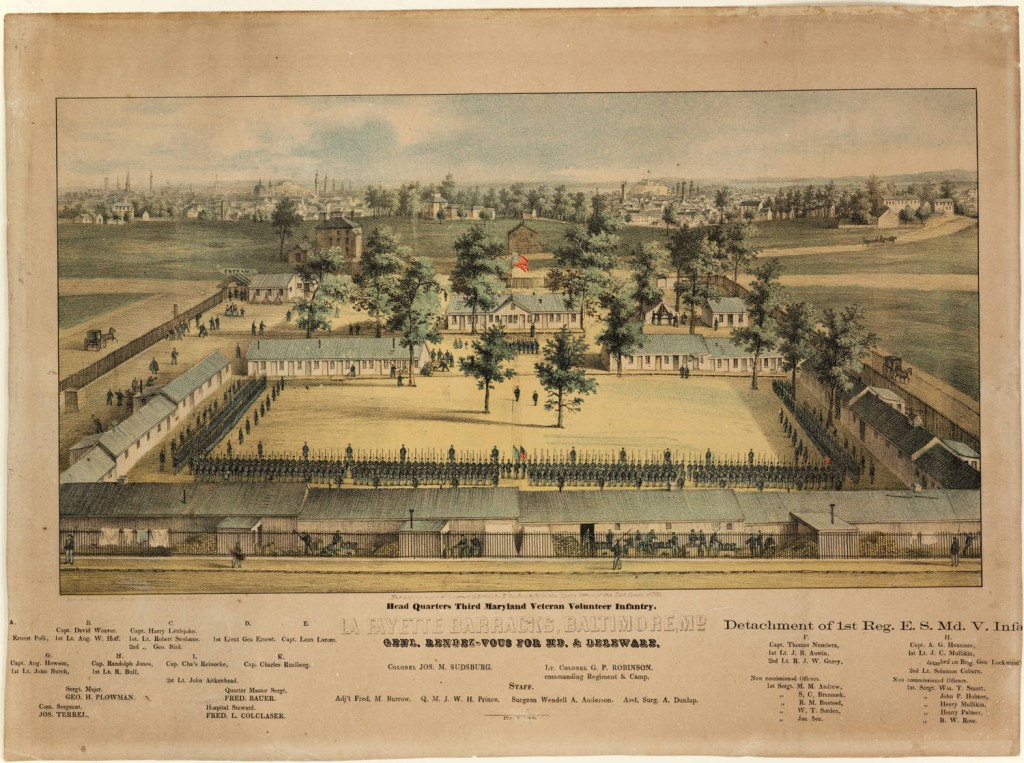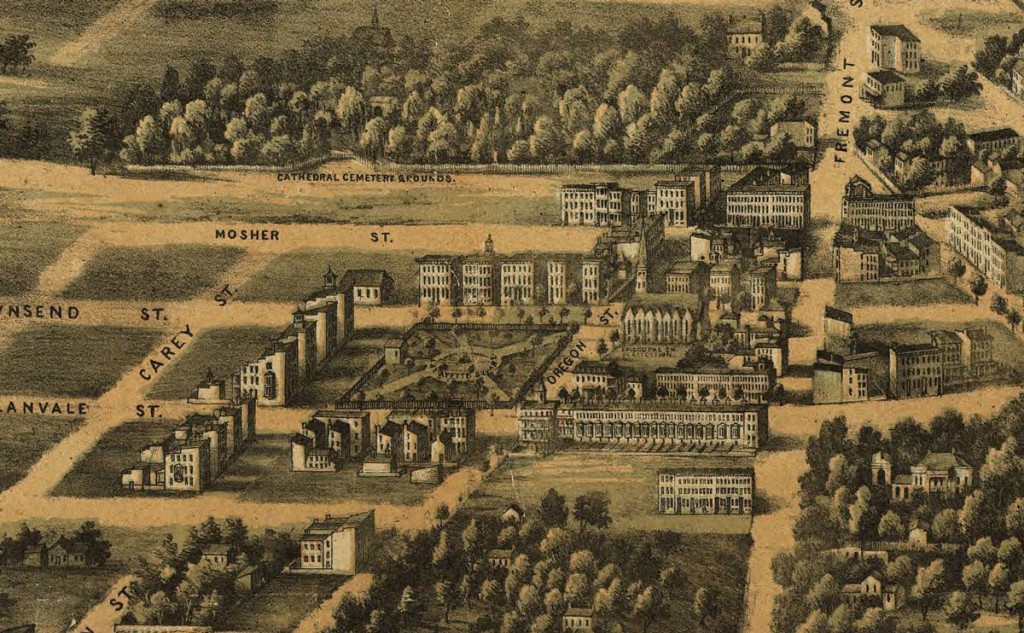Platted as an urban square in the early 1860s, Lafayette Square served as Camp Hoffman, the barracks for the 3rd Maryland Infantry from 1861 to 1865. After the Civil War, the area around the square developed rapidly, becoming the centerpiece of a prosperous urban neighborhood. Read on to explore the history of Lafayette Barracks, learn more about our archeological investigation into the Civil War history of Lafayette Square, or learn more about the history of the Harlem Park neighborhood.
1857: Lafayette Square is established
In the early 1800s, the area of Lafayette Square made up a small section of the former Harlem Estate owned by Dr. Thomas Edmondson. After Edmondson’s death in 1856, the city of Baltimore passed an ordinance to establish a new park on an attractive parcel ( “covered with a fine grove of oak and other large forest trees” ) bounded by Townsend Street (now Carrollton Street ), Lanvale Street , Republican St. (now Lafayette Avenue) and Oregon Street (now Arlington Avenue). The city spent $15,000 buying the land and paving the streets around the square. If local property owners could build six houses on all four streets facing Lafayette Square, the ordinance authorized the Mayor to have the square “railed in with good and substantial iron fence, and also to have the necessary grading done.” [footnote]LOCAL MATTERS The Sun (1837-1985); Jul 12, 1856; pg. 1[/footnote]
In 1881, historian John Thomas Scharf recalled the effort to develop the park and the surrounding blocks, writing:
“Lafayette Square… was purchased under the ordinance April 28, 1857, from Messrs. Knell, Rice, Hoffman, and others, for fifteen thousand dollars. In February, 1859, a company of citizens interested in the property in the vicinity, was formed with Jacob Hoff as president; William Carmichael, secretary; and Frederick Weiss, treasurer; and in March following the grading of the streets around the square was commenced.”[footnote]John Thomas Scharf, History of Baltimore City and County, from the earliest period to the present day (L.H. Everts, 1881), 280.[/footnote]
These early steps towards development, however, were brought to a sudden halt by the start of the Civil War in April 1861.
1861: Civil War begins, Lafayette Barracks built
When the Civil War began, Baltimore’s early resistance to Union troops and the critical importance of Maryland as a border state adjoining the District of Columbia encouraged the development of a ring of fortifications and encampments all around the city.

At Lafayette Square the first Union troops arrived by October 1, 1861 and established Camp Hoffman for the Fifth Maryland Infantry Regiment, under Colonel William Louis Schley. The Camp was named after the Hon. Henry W. Hoffman, who was the collector for the Port of Baltimore. The Barracks served several regiments during the four years it was in use. At least five Maryland regiments were stationed at the barracks, and several other state regiments were stationed there as well, including the 5th New York Artillery (1862), and the 8th New York Heavy Artillery (1864).
Regiments were stationed at Lafayette Barracks for a few weeks to several months at a time. Imagining the scene of Baltimore during the Civil War from the stand point of a little over ten years later, John Scharf described the use of Patterson Park and Lafayette Square during the Civil War, writing,
“But now in this beautiful city, since it is almost impossible in many cases to reproduce the scenes of the past. Patterson’s Park and Lafayette Square, the favorite pleasure grounds of Baltimore, presented far different aspects: one the site of an immense hospital, its longs rows of wards and barracks filled with soldiers; and the other the camp of various companies, armed sentries pacing where happy children now disport. So late as 1865 Lafayette Square was filled with ugly wooden sheds, swarming with rough troops, while not one of the elegant mansions now surrounding it had been reared.”[footnote]John Thomas Scharf, The Chronicles of Baltimore (Turnbull Bros., 1874), 616.[/footnote]
One account published in 1879 offer details on the camp:
“Again at Lafayette Square, in Baltimore, Maryland, the barracks was in the form of a square; the men, to the number of about 1,000, occupied three sides, and the officers the fourth. The hospital was directly in front of the officers quarters.
Correspondence from the period suggests that the camp may have served as a refuge for individuals, who had escaped from enslavement in rural Maryland,
After Colonel Gunther’s release became to me and asked permission to go to the barracks of the Purnell Legion, in Lafayette Square, to search for a negro belonging I think to his niece and supposed to have been brought from the Eastern Shore of Virginia by some of the men. I declined to give him the desired permission on the ground that I had no authority to surrender fugitives from labor or service and that he must have recourse to the civil authorities for redress. I understood afterwards that he procured a warrant from a magistrate and that he was admitted to the encampment with the officer to identify the supposed fugitive who was not found.[footnote]Robert Nicholson Scott et al., The war of the rebellion (Govt. Print. Off., 1891), 54.[/footnote]
The occupation of the park by Union troops ended in October 27, 1865. The encampment’s frame buildings were removed before the end of the year and the city began to try to reestablish the Square as a park.
1865: Development of Lafayette Square resumes
Lafayette Square was returned to its intended purpose as a recreation area, and a cast-iron fence, very typical of urban parks at the time, was constructed around the green space of the square. These fences, along with several other original features were removed by the city in 1873. The bronze fountain was added to the square in 1872.[footnote]John Thomas Scharf, History of Baltimore City and County, from the earliest period to the present day (L.H. Everts, 1881), 280.[/footnote]

